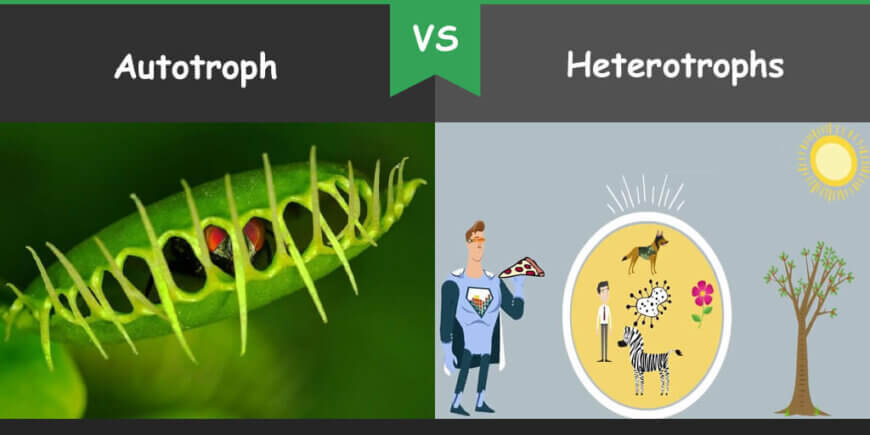Heterotrophs are the organisms which cannot synthesize their own food and depend on others for nutrition and food. For example, cow, lion, horse, cat are heterotrophs. Conversely, the group of organisms which prepare their own food with the help of air, water and sunlight are called autotrophs. For example, green plants, algae and a few bacteria are autotrophs.

Our earth has many organisms not just humans. All need energy and nutrition for their development and growth. Heterotrophs and autotrophs are two categories of the organisms based on the mode of nutrition or the way of consumption of food. In the food web hierarchy, autotrophs are called primary producers as they are able to prepare or produce food for themselves. Heterotrophs are regarded as the secondary or tertiary consumers in the food web hierarchy as they depend directly or indirectly on others.
| Basis for Comparison | Heterotrophs | Autotrophs |
| Definition | Organisms which use organic compounds to synthesize other organic compounds are called heterotrophs. | Organisms which use light energy to synthesize organic compounds are called autotrophs. |
| Etymology | Greek word. Hetero means different, trophe means nourishment. | Greek word. Auto means self and trophe means nourishment. |
| Food | Inorganic material (carbon dioxide, water, sunlight) | Depend on others |
| Food chain level | Secondary and tertiary | Primary |
| Pigments | Chlorophyll | No pigments |
| Influenced by | Biochemical catalytic substance, water, humidity temperature. | Digestive enzymes and nature of food (vegetarian or non -vegetarian) |
| Types | Omnivores, herbivores, carnivores and decomposers | Photo synthetics and chemo synthetics |
| Examples | Animals, human beings | Plants, algae, phytoplankton and bacteria |
Contents
What is Heterotrophs?
The word “heterotroph” is derived from the Greek word in which “hetero” means different and “trophe” means nourishment. So the organisms which obtain their nutrition by eating plants, other animals and by decomposition of matter are placed in this category. In cellular respiration, sugar and oxygen are utilized to produce carbon dioxide, water and energy in the form of adenosine triphosphate (ATP). ATP is the main form of energy used by the heterotrophs. Heterotrophs are not able to produce energy and nutrition for themselves so they absorb or obtain from others.
Heterotrophs are classified into two different ways. In first classification, they are either photo heterotrophs or chemo heterotrophs. In second type of classification, they are of four types; herbivores, carnivores, omnivores and decomposers.
Photo heterotrophs are the organisms which use light as energy but cannot get carbon from carbon dioxide so they obtain carbon from other organic compounds such as carbohydrates, alcohol and fatty acids. For example helicobacteria are the photo heterotrophs. Chemo heterotrophs are the organisms which get their energy from by the oxidation of organic compounds. For example, fungi, bacteria and pathogens are chemo heterotrophs.
In second type of classification, Herbivores are the organisms or animals that only eat plants for the nutrition for example, goat, cow, deer etc. Carnivores are the heterotrophs which eat only meat of other animals such as lion, fox, tiger etc. Omnivores are the heterotrophs which obtain food from both plants and animals such as human beings are omnivores. Decomposers are saprophytes which obtain nutrition from dead and decay matter for example a fungus. Sometimes, decomposers are not considered heterotrophs.
What is Autotrophs?
Autotrophs are the group of organism which are considered primary producers in the food chain hierarchy. The word “autotrophs” is from Greek language where “auto” means “self” and “trophe” means “nourishment”. Autotrophs are capable of producing their own food through photosynthesis or chemosynthesis by using water, air and sunlight.
Plants with green leaves, mosses, algae and phytoplankton use photosynthesis to acquire energy. In the process of photosynthesis, plants take energy from the sun and use them to convert carbon dioxide from the air and water from the soil into a nutrient called glucose. In photosynthesis, light energy is converted into chemical energy. Glucose is the form of a sugar and a nutrient for the plants. This is also used to make cellulose which help plants in rigidity of cell wall. Autotrophs do not move to other places in search of food.
Some autotrophs use another process instead of photosynthesis, chemosynthesis in which they use energy from chemical reactions to make food rather than obtaining light as energy source. Organisms which live in extreme environments for example bacteria living in active volcano or in deep oceans do chemosynthesis for food.
There is a class of plants which are called carnivores because they depend on living organisms for food. For example, pitcher plants are carnivores and also known as mixotrophic as they obtain energy from both plants and animals. They perform photosynthesis as well as chemosynthesis.
Key Differences between Heterotrophs and Autotroph
- Heterotrophs eat other organism to get food and energy whereas autotrophs synthesize their own food and energy
- Heterotrophs do not store energy whereas autotrophs store energy in the cells in the form of ATP.
- Heterotrophs are at the secondary and tertiary levels in the food chain web whereas autotrophs are at the primary level in the food chain web.
- Heterotrophs act a role of consumer in the food web whereas autotrophs act a role of producers in the food web.
- Heterotrophs can move from one place to another in the search of food whereas autotrophs cannot move from one to other place in search of food.
- Carnivores, omnivores, herbivores and decomposers are types of heterotrophs whereas photo synthetics and chemo synthetics are types of autotrophs.
Key Similarities
- Both are living things.
- Both convert small molecules into large molecules during their processes.
Conclusion
In conclusion, both heterotrophs and autotrophs have many dissimilarities but the main difference is that heterotrophs do not prepare their own food and depend on others whereas autotrophs synthesize their own food.